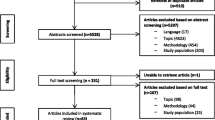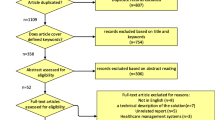Abstract
Objective
Examine psychometric properties of the SF-36 and SF-36E for mobility-impaired individuals and assess whether the SF-36E yields higher health-related quality-of-life scores.
Methods
We altered the SF-36 Physical Function scale by substituting the word “go” for “walk” and “climb” and changed the stem to reflect function using assistive devices. We compared responses between versions for 201 individuals with disabilities (n = 95 wheelchair users, n = 48 other device users, 58 = no device users).
Results
Both surveys yielded reliable scores, but floor and ceiling effects occurred with both versions. Confirmatory factor analyses demonstrate good fit for the SF-36 and SF36E, but were compromised by low sample size. Respondents demonstrated significantly better Role Physical, Bodily Pain, and Vitality on the SF-36E, but worse General Health.
Conclusions
The World Health Organization framework, the International Classification of Functioning, Disability, and Health (ICF) suggests that it is important to know both what one can do without assistance (capacity) and what one can do with assistance (performance). Results suggest that the SF-36E successfully measures performance among mobility-impaired individuals, including wheelchair users. However, further validation studies of the SF-36 and SF-36E are warranted with samples of individuals with disabilities.
Similar content being viewed by others
References
Ware, J. E., & Sherbourne, C. D. (1992). The MOS 36-item Short Form health survey (SF-36). I. Conceptual framework and item selection. Medical Care, 30, 473–483.
McHorney, C. A., Ware, J. E, & Raczek, A. E. (1993). The MOS 36-item short-form health survey (SF-36). II. Psychometric and clinical tests of validity in measuring physical and mental health constructs. Medical Care, 31, 247–263.
Jenkinson, C. A., Coulter, A., & Wright, L. (1993). Short form 36 (SF36) health survey questionnaire: Normative data for adults of working age. British Medical Journal, 306, 1437–4140.
Ware, J. E., Snow, K. K., Kosinski, M., & Gandek, B. (1993). SF-36 health survey: Manual and interpretation guide. Boston, MA: The Health Institute.
Gandek, B., Ware, J. E., Aaronson, N. K., Alonso, J., Apolone, G., Bjorner, J., Brazier, J., Bullinger, M., Fukuhara, S., Kaasa, S., Leplège, A., & Sullivan, M. (1998). Tests of data quality, scaling assumptions, and reliability of the SF-36 in eleven coutries: Results from the IQOLA Project. International Quality of Life Assessment. Journal of Clinical Epidemiology, 51, 1149.
Alonso, J., Ferrer, M., Gandek, B., Ware, J. E., Aaronson, N.K., Mosconi, P., Rasmussen, N. K., Bullinger, M., Fukhara, S., Kaasa, S., & Leplege, A. (2004). Health-related quality of life associated with chronic conditions in eight countries: Results from the International Quality of Life Assessment (IQOLA) Project. Quality of Life Research, 13, 283–298.
Findler, M., Cantor, J., Haddad, L., Gordon, W., & Ashman, T. (2002). The reliability and validity of the SF-36 health survey questionnaire for use with individuals with traumatic brain injury. Brain Injury, 15, 715–723.
Jacoby, A., Baker, G. A., Steen, N., & Buck, D. (1999). The SF-36 as a health status measure for epilepsy: A psychometric assessment. Quality of Life Research, 8, 351–364.
Stoll, T., Gordon, C., Seifert, B., Richardson, K., Malik, J., Bacon, P. A, & Isenberg, D. A. (1997). Consistency and validity of patient administered assessment of quality of life by the MOS SF-36: Its association with disease activity and damage in patients with systemic lupus erythematosus. Journal of Rheumatoid Arthritis, 24, 1608–1614.
Mahler, D. A., & Mackowiak, J. I. (1995). Evaluation of the short-form 36-item questionnaire to measure health-related quality of life in patients with COPD. Chest, 107, 1585–1589.
Wang, W., Lopez, V., Ying, C. S., & Thompson, D. R. (2006). The psychometric properties of the Chinese version of the SF-36 health survey in patients with myocardial infarction in mainland China. Quality of Life Research, 15, 1525–1531.
McHorney, C. A., Ware, J. E., Lu, J. F., Sherbourne, C. D. (1994). The MOS 36-item short form health survey (SF-36): III. Tests of data quality, scaling assumptions, and reliability across diverse patient groups. Medical Care, 32, 44–66.
Andresen, E., Gravitt, G. W., Aydelotte, M. E., & Podgorski, C. A. (1999). Limitations of the SF-36 in a sample of nursing home residents. Age and Ageing, 28, 562–566.
Freeman, J. A., Hobart, J. C., Langdon, D. W., & Thompson, A. J. (2000). Clinical appropriateness: A key factor to outcome measure selection: The 36 item short form health survey in multiple sclerosis. Journal of Neurosurgery in Psychiatry, 68, 150–156.
Hobart, J., Freeman, J., Lamping, D., Fitzpatrick, R., & Thompson, A. (2001) The SF-36 in multiple sclerosis: Why basic assumptions must be tested. Journal of Neurosurgery in Psychiatry, 71, 363–370.
Vickrey, B. G., Hays, R. D., Genovese, B. J., Myers, L. W., & Ellison, G. W. (1997). Comparison of a generic to disease-targeted health-related quality of life measures for multiple sclerosis. Journal of Clinical Epidemiology, 50, 557–569.
Hagen, S., Bugge, C., & Alexander, H. (2003). Psychometric properties of the SF-36 in the early post-stroke phase. Journal of Advanced Nursing, 44, 461–68.
Hobart, J. C., Williams, L. S., Moran, K., & Thompson, A. J. (2002). Quality of Life measurement after stroke: Uses and abuses of the SF-36. Stroke, 33, 1348–1356.
O’Mahoney, P. G., Rodgers, H., Thomson, R. G., Dobson R., & James, O. F. (1998). Is the SF-36 suitable for assessing health status of older stroke patients? Age and Ageing, 27, 19–22.
Andresen, E. M., Fouts, B. S., Romeis, J. C., & Brownson, C. A. (1999). Performance of health-related quality of life instruments in a spinal cord injured population. Archives of Physical Medicine and Rehabilitation, 80, 877–884.
Mattson-Prince, J. (1997). A rational approach to long-term care: Comparing the independent living model with agency-based care for persons with high spinal cord injuries. Spinal Cord, 35, 326–331.
Meyers, A. R., & Andresen, E. M. (2000). Enabling our instruments: accommodation, universal design, and assured access to participation in research. Archives of Physical Medicine and Rehabilitation, 81(12 supplement 2), S5–S9.
Froehlich-Grobe, K., Figoni, S. F., Thompson, C., & White, G. W. Exploring the health of women with mobility impairments, manuscript under review.
Marge, M. (1988). Health promotion for persons with disabilities: Moving beyond rehabilitation. American Journal of Health Promotion, 2(4), 29–44.
Rimmer, J. H. (1999). Health promotion for people with disabilities: The emerging paradigm shift from disability prevention to prevention of secondary conditions. Physical Therapy, 79(5), 495–502.
ICF Beginner’s Guide Online. (2002). Towards a common for functioning, disability, and health. World Health Organization, Geneva. http://www.who.int/classifications/icf/site/beginners/bg.pdf.
Mosier, C. I. (1943). On the reliability of a weighted composite. Psychometrika, 8(3), 161–168.
Jöreskog, K., & Sörbom, D. (2001). LISREL 8: User’s reference guide. Lincolnwood, IL: Scientific Software International, Inc.
Bollen, K. (1989). Structural equations with latent variables. New York: Wiley.
Browne, M., & Cudeck, R. (1993). Alternative ways of assessing model fit. In K. Bollen &J. Long (Eds.), Testing structural equation models (pp. 136–162). Newbury Park, CA: Sage.
Hu, L., & Bentler, P. (1999). Cutoff criteria for fit indexes in covariance structure analysis: Conventional criteria versus new alternatives. Structural Equation Modeling, 6(1), 1–55.
Hoyle, R., & Panter, A. (1995). Writing about structural equation models. In R. Hoyle (Ed.), Structural equation modeling: Concepts, issues, and applications Thousand Oaks, CA: Sage Publications.
Fleiss, J. L. (1981). Statistical methods for rates and proportions (pp. 212–225). New York: Wiley.
McHorney, C. A., & Tarlov, A. R. (2001). Individual-patient monitoring in clinical practice: Are available health status surveys adequate? Quality of Life Research, 4, 293–307.
Gandek, B., Sinclair, S. J., Kosinski, M. A., & Ware, J. E. (2004). Psychometric evaluation of the SF-36 health survey in Medicare managed care. Health Care Financing Review, 25, 5–25.
Acknowledgements
This work was funded, in part, by two grants from Centers for Disease Control and Prevention: the Office of Disability and Health grant to The University of Kansas (R04/CCR717707-01) and the Prevention Research Center at Saint Louis University (U48CCU710806). Thanks to study contributors: Stephen F. Figoni, PhD; Jessica Roberts, PhD; Dot Nary, MA; and Janet Marquis, PhD and to Kathleen Wyrwich, PhD, for her assistance with statistical analyses. Finally, thanks to the ILCs and respondents for participating.
Author information
Authors and Affiliations
Corresponding author
Additional information
Results were presented to the DisAbility Forum of the American Public Health Association’s 131 Annual Meeting in San Francisco, CA in November 2003.
Appendices
Appendices
Rights and permissions
About this article
Cite this article
Froehlich-Grobe, K., Andresen, E.M., Caburnay, C. et al. Measuring health-related quality of life for persons with mobility impairments: an enabled version of the short-form 36 (SF-36E). Qual Life Res 17, 751–770 (2008). https://doi.org/10.1007/s11136-008-9342-5
Received:
Accepted:
Published:
Issue Date:
DOI: https://doi.org/10.1007/s11136-008-9342-5




